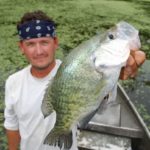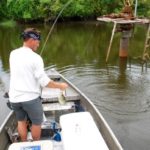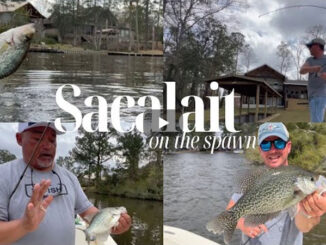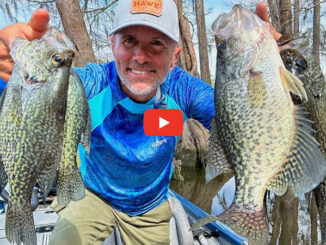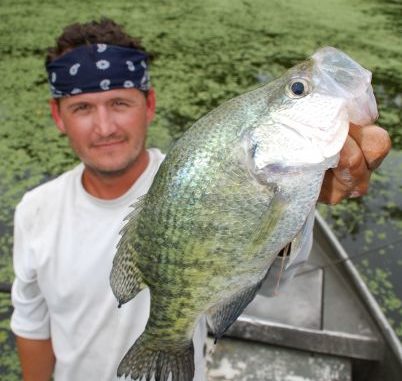
The Atchafalaya Basin’s unpredictable waters can drive anglers nuts, but this Jeanerette fisherman has it all figured out. Learn how he reads the waters to know when and where to catch limits of sac-a-lait.
“In a perfect world, it would be 10 feet on the Butte La Rose gauge with a slow fall, year around,” the rakish young man told me with an infectious grin.
The Butte La Rose gauge on the Atchafalaya River is what most fishermen — whether for sac-a-lait, bass, bream or catfish — go by to decide when and where to fish the vast Atchafalaya Basin.
The speaker was 33-year-old Rhett Buteau of Jeanerette. Lean, with chiseled good looks and a closely cropped, stubbly beard (“I hate to shave,” he explained), he was wearing a blue bandana wrapped around his head, pirate-fashion.
I was happy to finally be on the water with him. The trip was on, and then off. Then back on. Then off.
In one of those spring and summer Louisiana patterns, rain clouds had been banding northeasterly from the Gulf of Mexico. It had been raining three straight days.
In an anguished voice over the phone he finally told me the trip was a go.
“Come on. I’m on the fish right now,” Buteau said.
We woke to thunder and a gentle rain the next morning, so we hunkered down over coffee until 6:30 a.m. By the time we got to the Myette Point boat landing, it had stopped raining, but not stopped threatening more rain.
His boat was not a typical sportfishing craft. Rather it was a 16-foot custom-welded aluminum commercial crawfishing boat powered by a 50-horsepower Yamaha.
Buteau fished from the boat’s sharp prow and controlled its movements with a simple hand-control trolling motor clamped on the left bow.
When Buteau pulled into the set of oilfield canals in which he was going to concentrate, he was wearing a predatory grin, like a lion that just stumbled on a crèche of helpless, newborn wildebeest calves.
He stopped his outboard motor in a fishy-looking dead-end canal, clamped the trolling motor to the gunnel and dropped its head into the water.
At first touch of the control, Buteau’s expectant leer turned into a dark scowl as a puff of bluish smoke rose from the control and the motor stopped working.
Not one to be thwarted, he grabbed his tool box and knocked off the cover of the control head, revealing a spaghetti tangle of wires. After 10 minutes of jiggering, he had it functioning, in a Rube Goldberg manner.
Every time he wanted to use it the rest of the day he had to physically connect wires. It got us through the day, but it was comical to see a blue puff of smoke rise over the bow every fourth or fifth time he used it.
He eased the skiff up to a likely looking bush, and dropped a cork and jig into a small opening.
I received Lesson No 1: Rhett Buteau’s corks don’t float.
Rather, they very slowly sink deeper and deeper.
“The slow fall drives the fish crazy,” Buteau explained. “I watch it as it sinks for any movement. I only let it sink till it’s out of sight — 10 inches in this water.”
It didn’t make it that deep before Buteau was levering an average-sized sac-a-lait out of the drink.
“I can still fish the cork like a regular cork by regular movement,” Buteau said as he unhooked the fish. “I am constantly popping the cork. Any twitch means a bite.”
Buteau fished from a semi-crouched position, with his left hand positioned on his hip. His fierce focus on the cork didn’t keep him from talking, however.
“When fish are hungry and feeding aggressively, they will be on the outer edge of cover,” he explained. “When they aren’t, they are back up in the cover waiting for a cheap meal.”
Every time, Buteau unhooked and stowed a fish, he checked his wristwatch. Curious about his obsession with time, I asked him about it.
Laughing, he explained that he keeps track of the number of fish he has caught by using the start-stop clicker on the stopwatch feature of the wristwatch.
“I wear the clicker on my wristwatch out,” Buteau said. “Few people have that problem. Fifty fish is a lot.”
He moved the boat from likely spot to likely spot without fishing every foot of the bank. If the spots were close together, he trolled to them with his crippled trolling motor; if farther apart, he cranked his outboard.
“It’s a waste of time to comb every inch,” he said. “By the time I find one piece of hidden cover, I could catch 20 fish in good cover.”
Buteau ferociously wrenched fish from the water and quickly unhooked them.
And he fished fast.
“It’s important to keep fish going,” Buteau said. “It’s hard to keep fish biting. That’s why I don’t use a net — it slows you down.”
Few grass beds were present in this field of canals, but he pounded brush and laydowns hard. Wellheads were easiest; he kept his boat dancing around the well while he whipped fish after fish out from under the structure.
He fished like a machine — relentlessly.
By 2 p.m., he hit his crappie limit, plus he had a passel of bream and bass.
With a satisfied smile, he talked about the forces that shaped him.
“I was close to (LSU baseball coach) Smoke Laval,” Buteau said. “He was one of the smartest men I ever knew. He taught me to be a winner — not just in baseball, but in other things in life. Be the best, even if it’s just picking up sticks. Pick them up in half the time others do; then rake the yard.
“Skip Bertman taught me to play like my parents are watching. Every day I go fishing, I fish like my parents are watching.”
